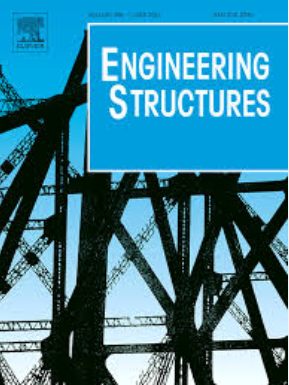A hybrid domain adaptation approach for estimation of prestressed forces in prestressed concrete bridges under moving vehicles
IF 5.6
1区 工程技术
Q1 ENGINEERING, CIVIL
引用次数: 0
Abstract
Ensuring the accurate and reliable estimation of prestressed forces (PFs) in prestressed concrete bridges is vital for operational performance and public safety. Traditional vibration-based methods often face challenges when applied to real-world scenarios. In this study, a novel hybrid domain adaptation approach is proposed to predict the prestressed force of prestressed concrete bridges under moving vehicles. The finite element model for Vehicle-Bridge Interaction (VBI) systems is established and validated using the experimental results. This validated model is then used to generate a synthetic training dataset of the source domain. Continuous Wavelet Transform (CWT) is employed for feature extraction from VBI acceleration responses, capturing their time-frequency properties. Preliminary feature extraction is enhanced through the use of a pre-trained AlexNet network. Following this initial step, a novel hybrid domain adaptation (DA) approach is applied to close the gap between the synthetic and real-world data. Specifically, Maximum Mean Discrepancy (MMD) and adversarial DA techniques are synergistically combined. Three types of loss functions are incorporated: Regression Loss for precise force prediction, MMD Loss to align the synthetic and real-world data domains, and Adversarial Loss to ensure domain invariance. The effects of uncertainties in VBI system, such as errors of the bridge length, flexural rigidity, density, damping, boundary conditions, errors of the vehicle model and moving speed and road surface roughness, have been discussed. The results indicate that the integrated approach effectively mitigates the challenges posed by domain shift, enabling robust and reliable predictions of PFs in actual bridge structures. The finding of this study offers a comprehensive, data-driven solution with significant implications for the future of structural health monitoring and bridge condition assessment.
求助全文
约1分钟内获得全文
求助全文
来源期刊

Engineering Structures
工程技术-工程:土木
CiteScore
10.20
自引率
14.50%
发文量
1385
审稿时长
67 days
期刊介绍:
Engineering Structures provides a forum for a broad blend of scientific and technical papers to reflect the evolving needs of the structural engineering and structural mechanics communities. Particularly welcome are contributions dealing with applications of structural engineering and mechanics principles in all areas of technology. The journal aspires to a broad and integrated coverage of the effects of dynamic loadings and of the modelling techniques whereby the structural response to these loadings may be computed.
The scope of Engineering Structures encompasses, but is not restricted to, the following areas: infrastructure engineering; earthquake engineering; structure-fluid-soil interaction; wind engineering; fire engineering; blast engineering; structural reliability/stability; life assessment/integrity; structural health monitoring; multi-hazard engineering; structural dynamics; optimization; expert systems; experimental modelling; performance-based design; multiscale analysis; value engineering.
Topics of interest include: tall buildings; innovative structures; environmentally responsive structures; bridges; stadiums; commercial and public buildings; transmission towers; television and telecommunication masts; foldable structures; cooling towers; plates and shells; suspension structures; protective structures; smart structures; nuclear reactors; dams; pressure vessels; pipelines; tunnels.
Engineering Structures also publishes review articles, short communications and discussions, book reviews, and a diary on international events related to any aspect of structural engineering.
 求助内容:
求助内容: 应助结果提醒方式:
应助结果提醒方式:


